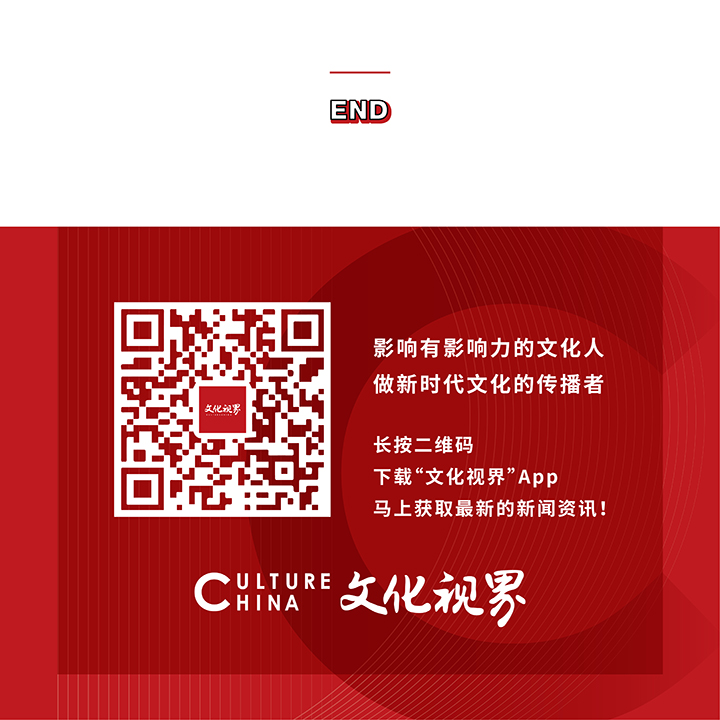

张江舟最近在“尘寰·墨语“展览中展出了一系列作品,其情感表达是严肃和强烈的。他的艺术语言从中国和西方绘画流派中汲取元素,由此演变而来。他以水墨为媒,将线、水、形交织在一起,形成了一种独特的人文主义表达,这种表达是以叙事和形式主义元素为主的。他用了一种扁平的视角,将厚重、湿润的笔触与具象的线条和形式相结合,画面中充满了具有魔幻现实主义的元素,如身体、手、眼睛、人和动物等,而这些元素又被置于一个令人困惑的现代主义意象图像中。这种丰富的意象需要观者去拆解和解读,去理解作品在表达什么,去提问我们在看谁?发生了什么?
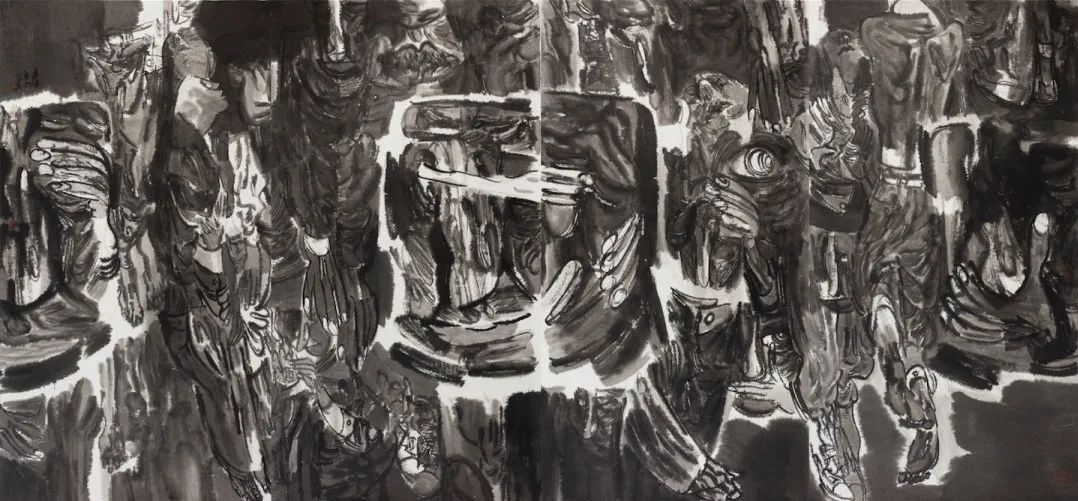
墨语|纸本水墨|200cm x 400cm 2021
在他的作品中,他刻画的人物形象的身体慵懒且具有表现主义的意味,手被拉得很长,让人联想到其他现当代画家,如凯绥·珂勒惠支(Kathe Kollwitz),卢西安·弗洛伊德(Lucien Freud)。密集交织的构图选择性地加入了中国传统绘画中普遍存在的留白,缓解了密集构图造成的紧张感。他将留白巧妙地穿插于二维图像中,以打破这种密集感,留白的运用有时也起到了拉开画面叙事距离的作用,让观者的视线得以暂停。虽然画作的整体基调是黑暗和紧张的、营造出了一种浓厚的绝望意境,但色彩的运用提亮了整个画面,装点以绿色和粉色、突出单个人物,增强个体在画面中的存在感。例如,一个脚尖离地的飘浮的矮小的女性形象,似乎像一个灵魂,让人想起夏加尔童话中飘浮的人物形象。
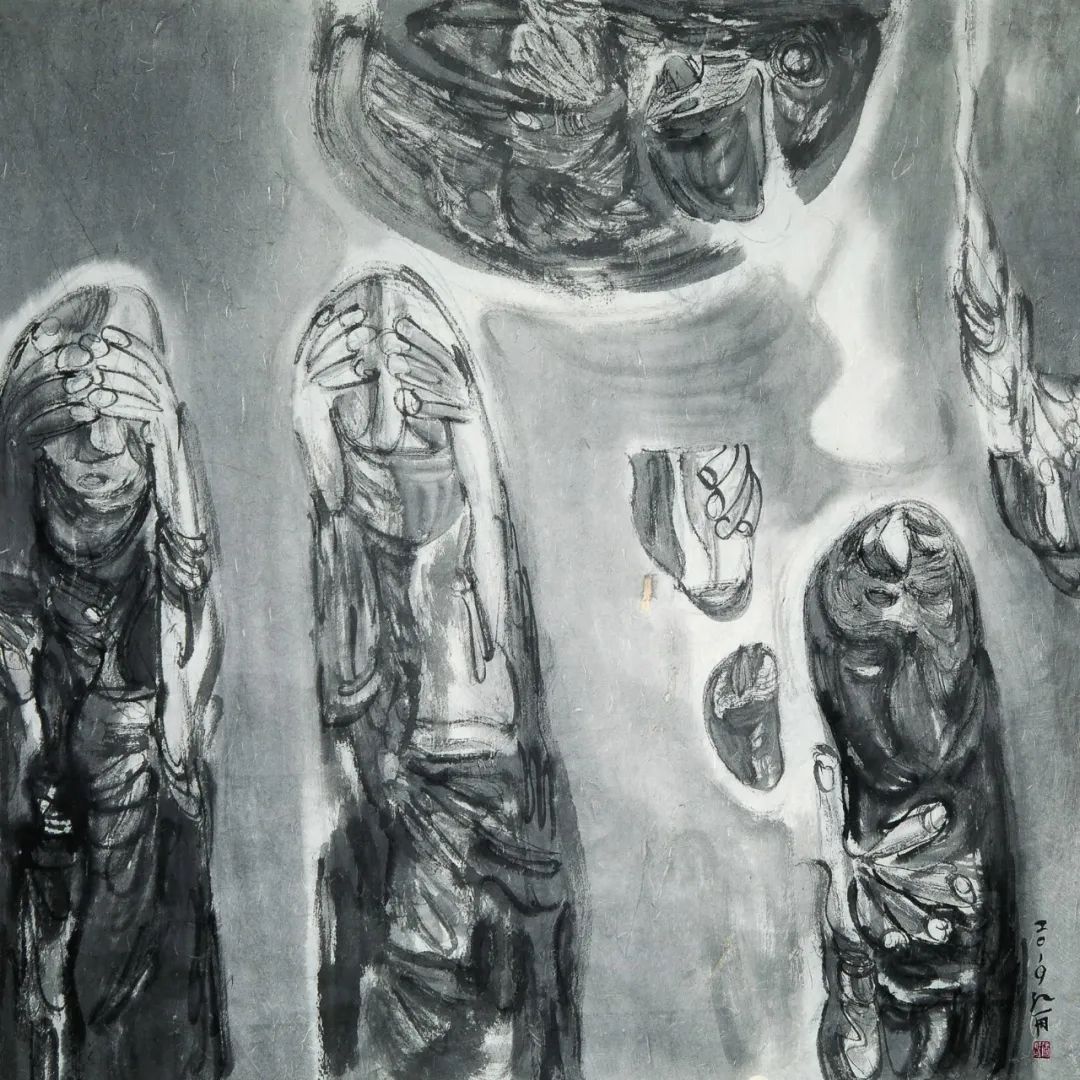
人类图像学研究-自闭|纸本水墨|130cm x 130cm 2019
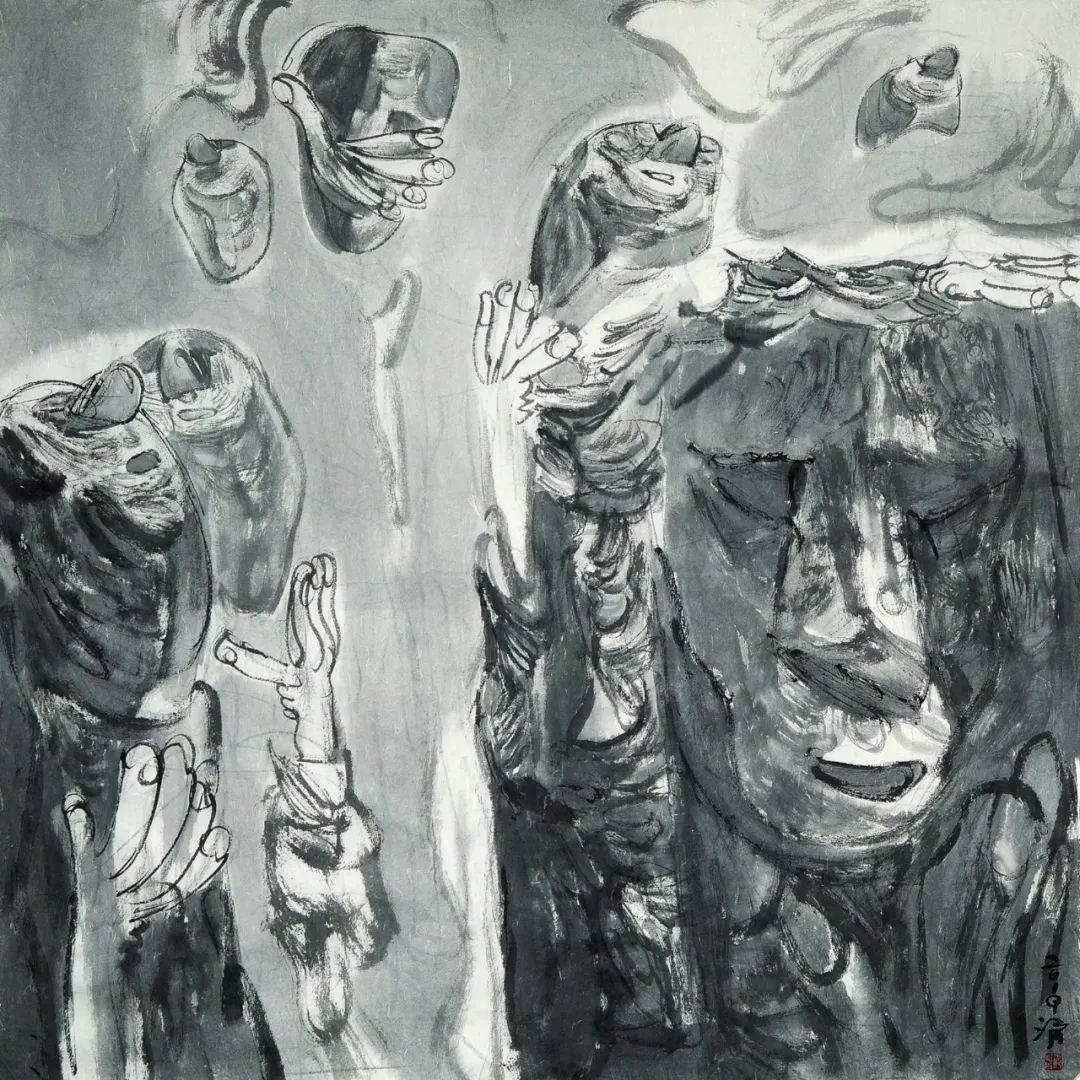
人类图像学研究-预言|纸本水墨|130cm x 130cm 2019
他的作品强烈地表达了灵魂的概念。这些灵魂呼应的是存在主义焦虑,以及精神孤立的时代中人类挣扎生存的状态。在过去两年的大流行中,张江舟对人们的心理状况有着深切的关注,而对人类的痛苦和对悲惨事件的社会关注也是他一直以来创作的核心。例如汶川大地震后,他创作了“生命·墨语“系列。追溯张江舟近年来的一些作品,它们之间既有强烈的联系,也有强烈的背离。究其原因还是自2019年底以来,世界发生了剧烈的变化,两年多后的今天,我们仍然深刻受到这些剧变的影响,这些变化使得世界四分五裂,并导致大规模孤立、恐惧和隔离。

人类图像学研究-图腾|纸本水墨|130cm x 130cm 2019
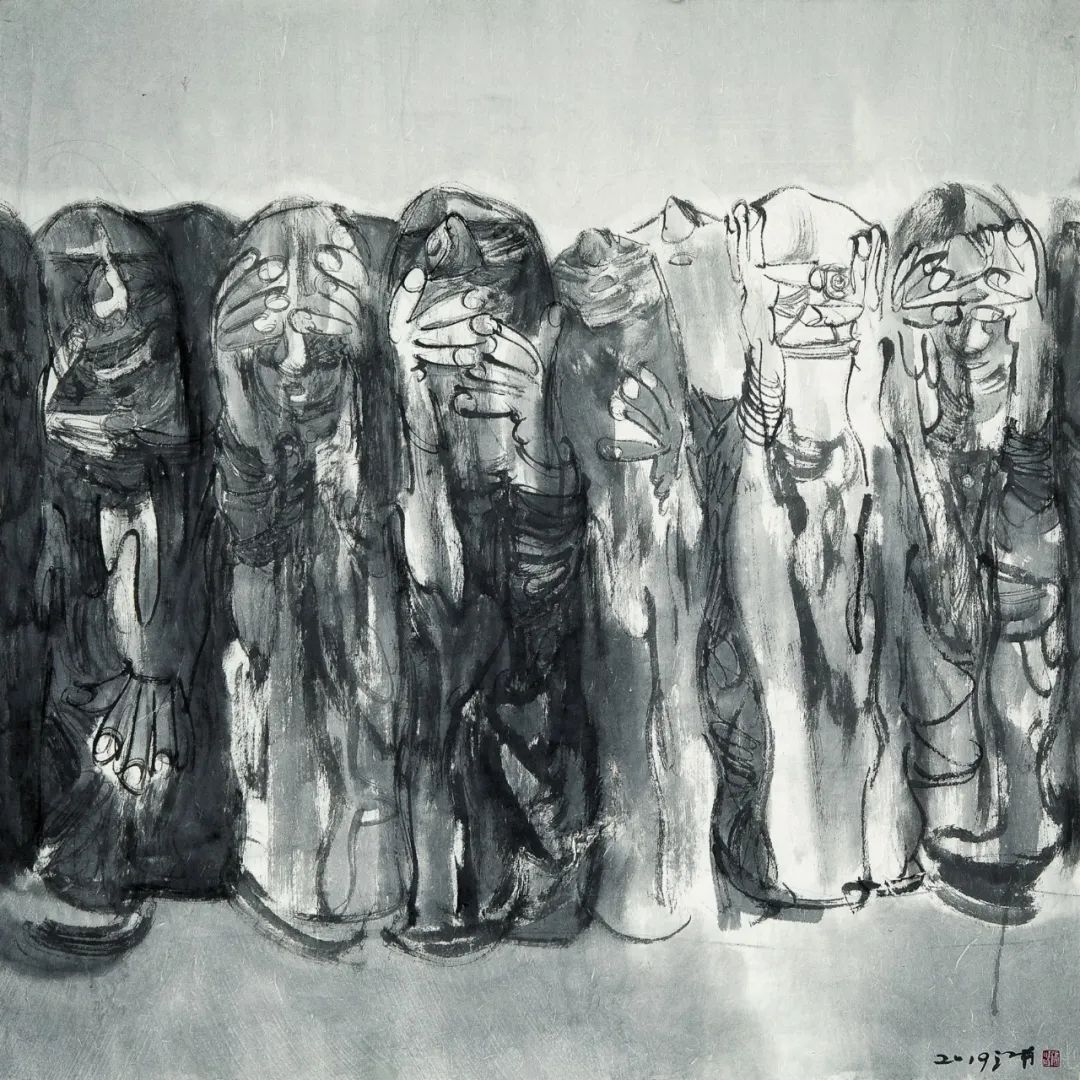
人类图像学研究-界限|纸本水墨|130cm x 130cm 2019
有两件作品特别值得一提,其一是《人类图像学研究·界限》。这似乎是一件实验性的作品,展现了一幅令人不安的黑白画面,一排人物紧紧地聚集在一起,双手环抱着低下的头,我们很难知道发生了什么,但他们似乎被制服了。他们看起来是孤立的,但却又相互束缚,与画面上下的留白相映衬,好似人类的悲伤和痛苦被排列成线。他们是站着还是坐着?他们似乎蹲着或弯腰。充满情感与戏剧性的大手指是这些人物的人性的象征。这些形象几乎是抽象和概念性的,但同时又清晰地具有具象性。我认为这幅作品描绘出了人类生存的现状,具有永恒性和超越性。
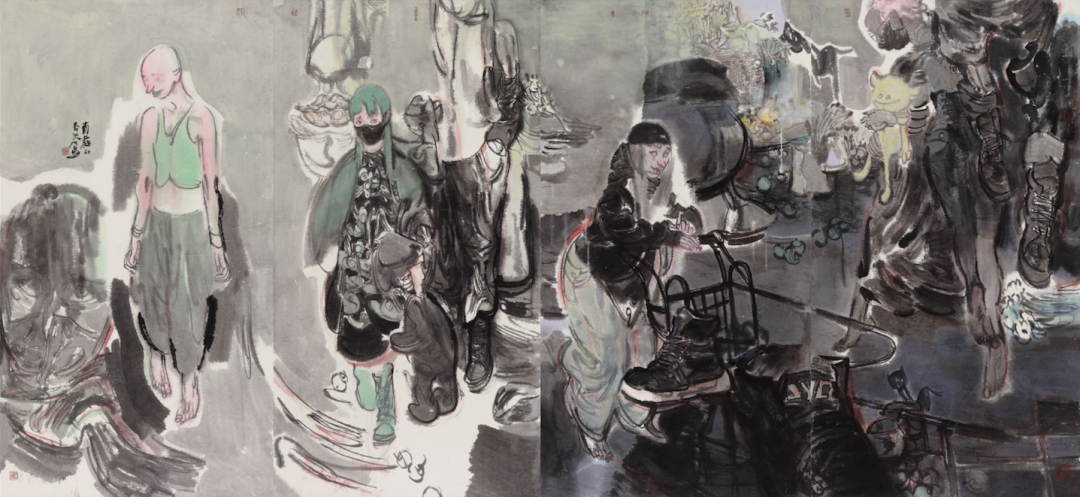
有霾的春天|纸本水墨|200cm x 400cm 2021
另一幅是在2021年创作的大尺幅代表作《有霾的春天》。在混乱的具象叙事中,各部分清晰地刻画了人物,多个年轻的女性形象在黑暗、艰难的环境中跳脱出来。一个戴着口罩的年轻女孩似乎抓着一只泰迪熊,走向画面外的观看者,左边是一个裸露手臂和腹部的女人,低头看着一些模糊的形象——可能是一个感染了病毒的家庭成员。一个戴着帽子穿着厚重的衣服但光着脚的女人,推着一辆超市手推车,朝我们瞥了一眼,前面有一只巨大的驯兽师摆着奇怪的姿势,挡住了我们的视线。绿色突出了一些细节,比如女人的上衣、女孩的头发和靴子,以及看起来像是一只猫的动物。在不确定的海洋中,人物形象清晰可见,预示着无论如何日常生活都必须继续。这件作品有趣的地方在于它对生活的描绘,也许取材于张江舟观察到的场景,并经过重新解读,塑造成一个碎片化的、但又引人入胜的故事情节。
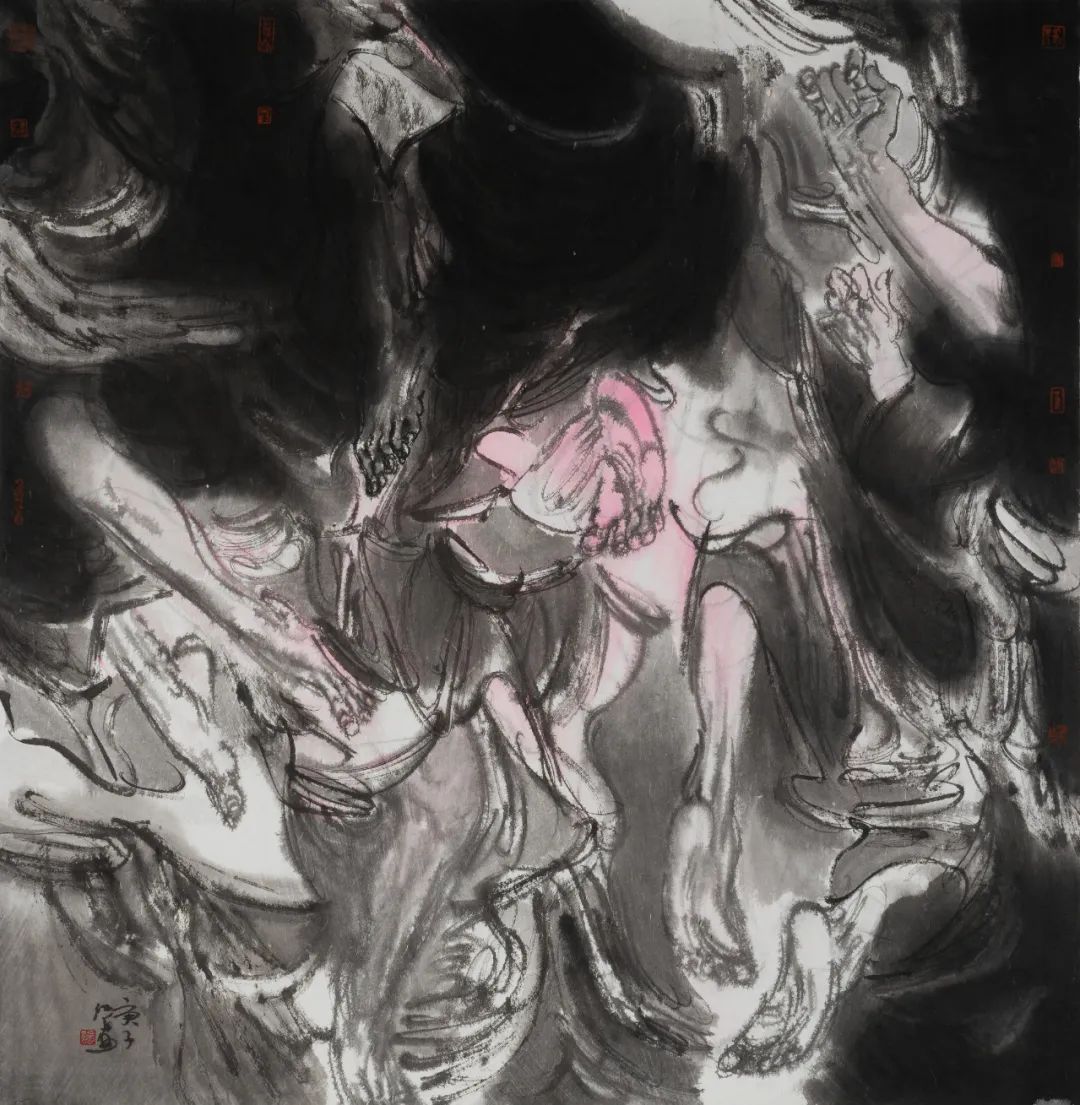
阙·子|纸本水墨|130cm x 130cm 2020
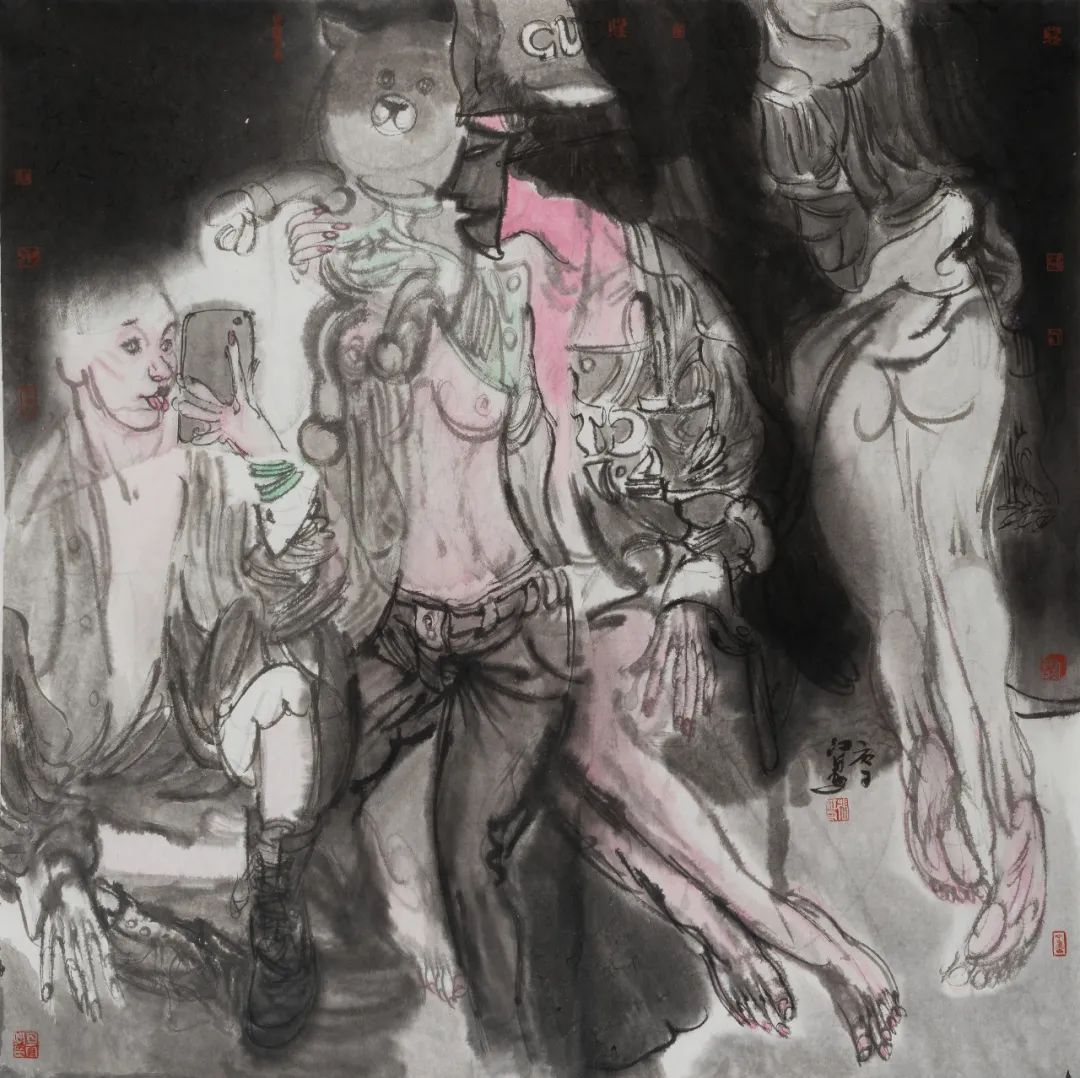
阙·丑|纸本水墨|130cm x 130cm 2020
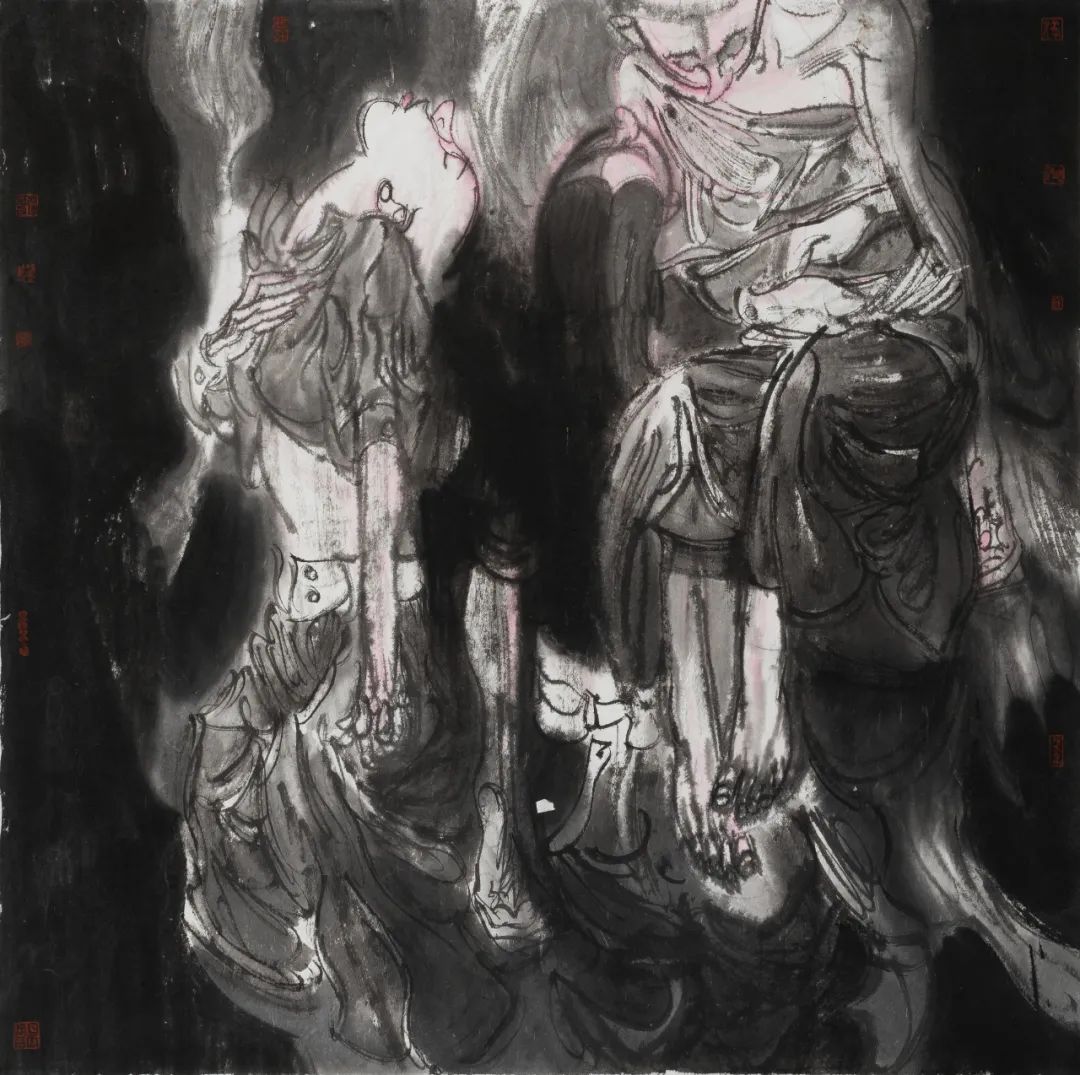
阙·寅|纸本水墨|130cm x 130cm 2020
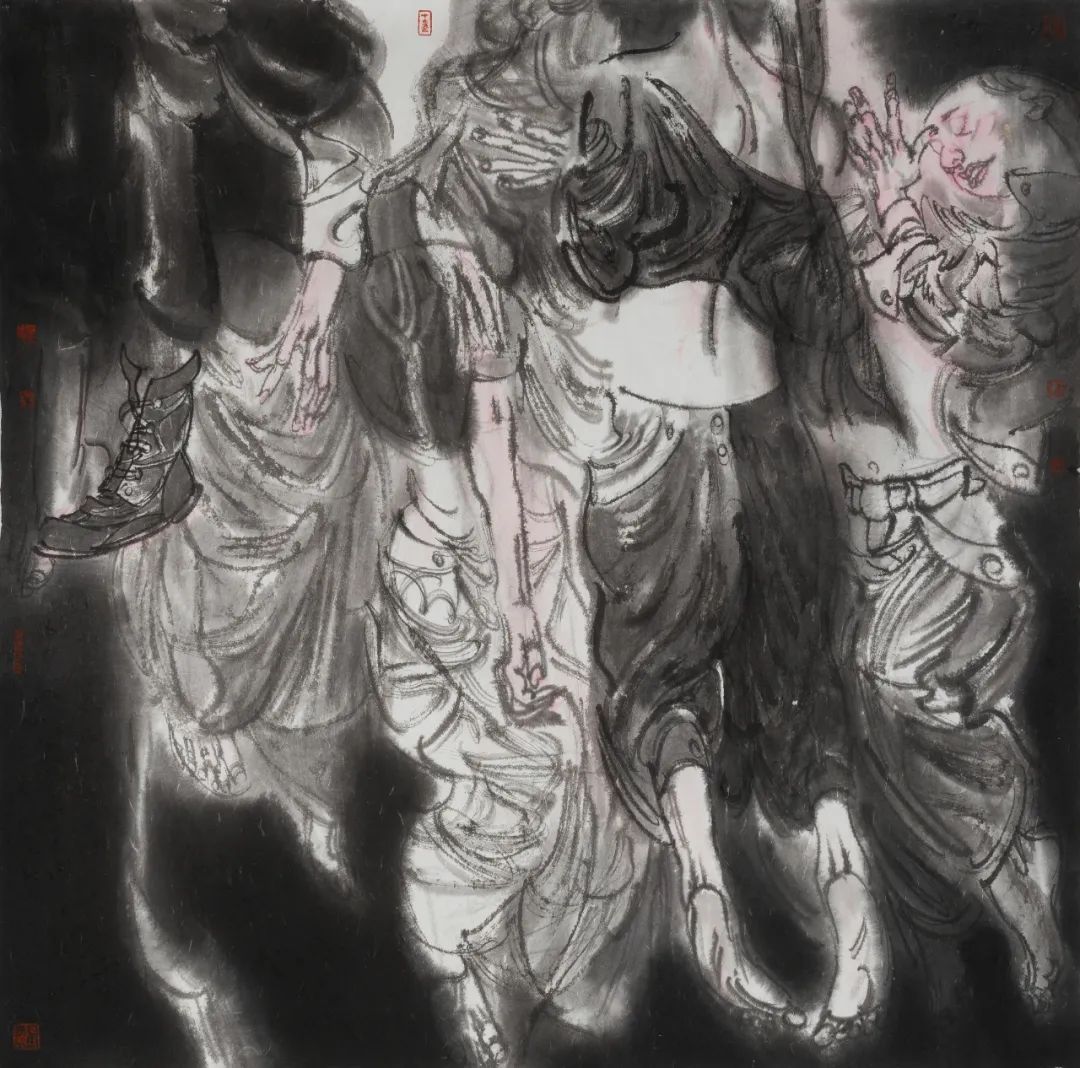
阙·卯|纸本水墨|130cm x 130cm 2020
“阙“系列是以中国古代记时系统的十二个地支为框架,这个系列呈现了一种混乱的叙述方式,不容易理解。模糊的图像使得观者必须仔细观察,才能厘清一些线索。人物、腿、带有清晰、精致的脚趾的尖脚;一张脸、以及穿着现代服饰的女人。焦虑的面孔、四肢伸展的身体,看似混乱、毫无意义的场景。我们真的能“读”懂这些画吗?一种不安、模糊、脱节的生活感觉,存在的片段让我们感到头晕、精神错乱、困惑。这些作品的灵感来源远不止两年,也许是几十年、几百年,甚至更久——几千年!水墨在中国有着悠久和持续的历史,从顾恺之等早期大师开始,画家们不断积累着视觉语言。人物画发展至今,水墨被融入到了人文主义的图像语言中,有了一种饱满而忧郁的描写力量。“积染”在他的绘画中被广泛使用,他在从深到浅墨色的表现上游刃有余,绿色和粉色的使用抵消了审美和象征意义,打破了当代绘画语言的固有逻辑,强调超现实和离奇,增强了意象的梦境状态。
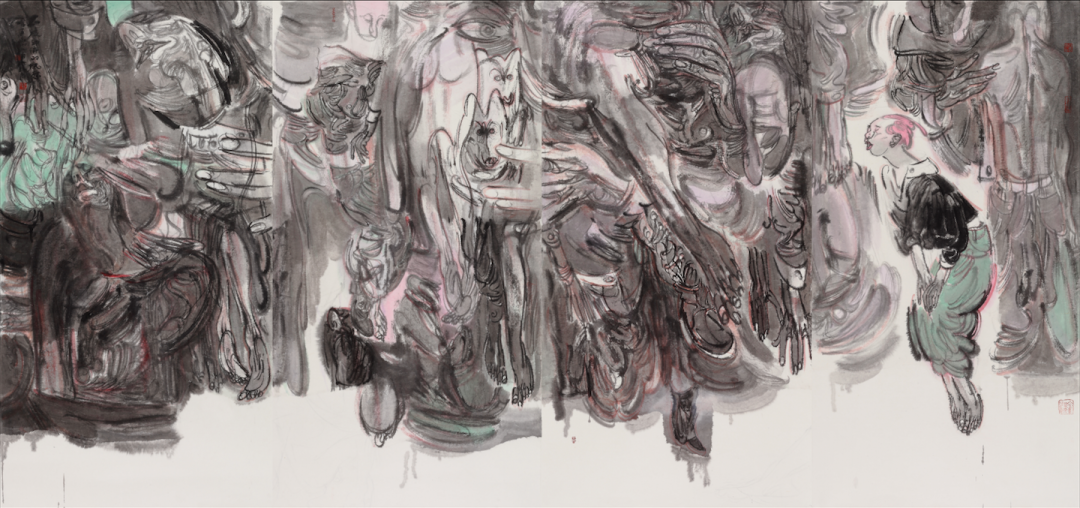
不该放弃的抚慰|纸本水墨|200cm x 400cm 2021
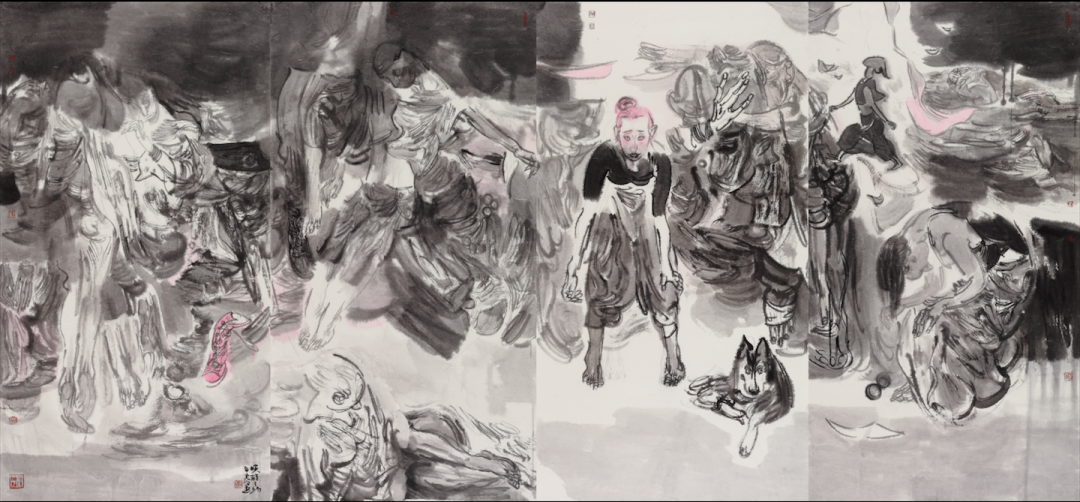
唤醒之约|纸本水墨|388cm x 180cm 2021
在2019年的一些作品中,我们可以看到本质上已经存在的东西:一组浓缩的、向下分开的图腾,图腾的牵引元素一致:大而沉重的手、古老的手、抓着的手,这是共同的人性的象征,这种象征意义可以追溯到史前时代。这些作品构思紧密、有力,使用一种直接的表达形式,充满了情感。紧凑的雕塑般的无定形的意象结合在一起,让人想起战后德国艺术家乔治·巴塞利兹(Georg Baselitz)的新现代主义作品,以及20世纪早期一些以灾难和战争为题的其他形式的艺术。在他的画中,我们看到的是一种将碎片拼凑在一起的悖论:有时这种聚集的无定形形态可以被识别为人类的痕迹,被孤立在一个虚空的、广阔的空间的中心,孤独但很完整,就好像即使周围的一切都崩溃了,它的灵魂仍然存活了下来。
近年来,张江舟的作品在尺寸上有了一定的突破。2021年的画作都是巨大的,由不同的部分组成,通过以爱、丧失、安慰和遗弃为主题来扩展了人类戏剧的领域,其效果是放大人性,使其更具有史诗性和紧迫性。
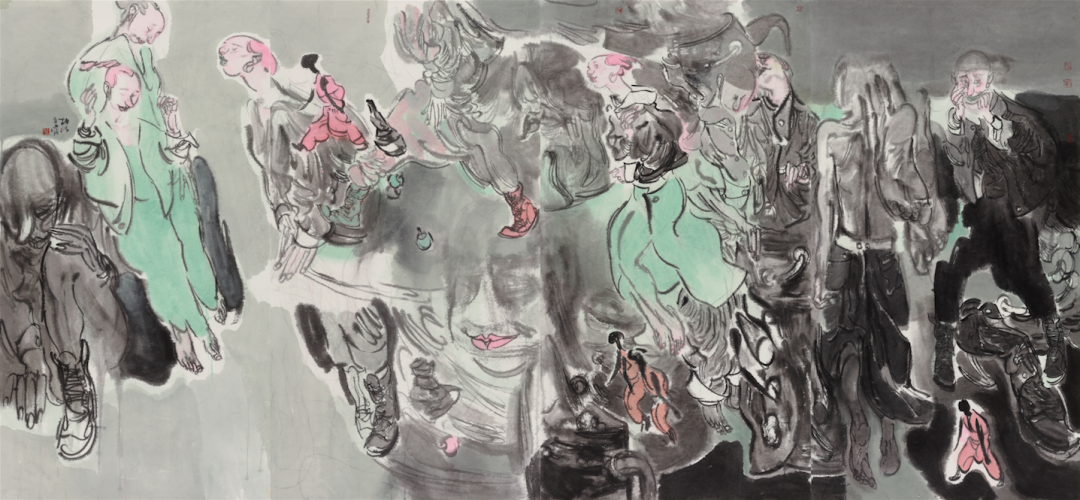
相约|水墨设色|200cm x 400cm 2021
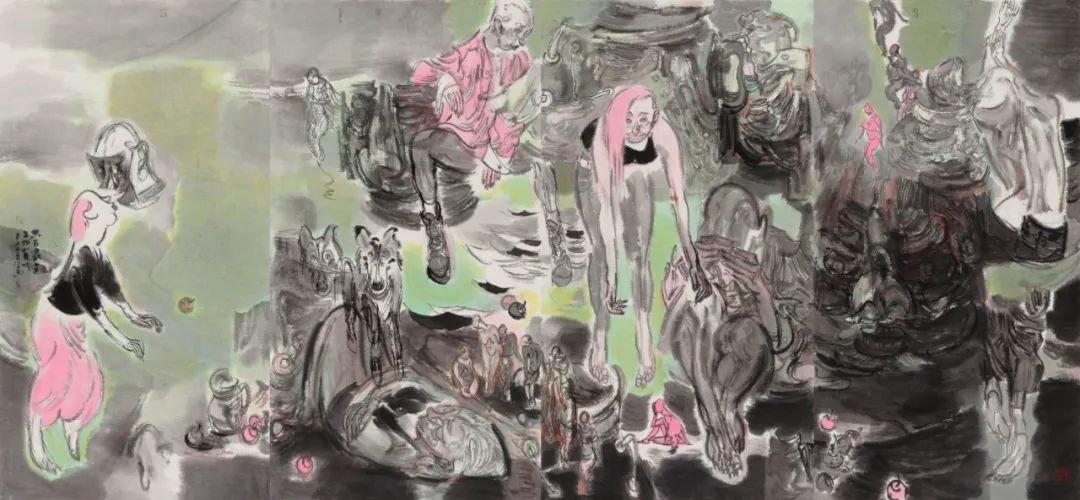
只有你能在这里找到爱情|水墨设色|200cmx400cm 2021
追溯中国艺术中人文主义文化表达的背景,可以更好的理解这些当代作品。20世纪70年代末,与文学、摄影和电影一起,人文主义在绘画中出现了第一次爆发,接下来十年的改革使这种表达得以扩展和多样化。水墨受人追捧至少要追溯到宋朝,而在过去30年间,水墨作为一种媒介又经历了一场复兴。与现代水墨作品并存的还有其他现代艺术传统,其中有德国表现主义的元素,还有弗朗西斯科·戈雅(Francisco Goya)等西班牙大师,或许还有委拉斯开兹(Diego Rodriguez de Silva y Velazquez)的作品。表现主义和抽象主义的融合徘徊在一种令人不安的超现实主义和梦幻般的视觉之间,和一种世俗的、鲜活的日常生活的现实之间。在我看来,漂浮的、悬浮的人物让我想起了夏加尔,以及其他西方经典早期基督教画作,一切都以幽灵般的形式出现,几乎看不见,但在某种程度上产生了共鸣。自然、精神和人类的遭遇在痛苦的漩涡中可见,生存、同情游离在焦点上或焦点外,像水一样具有流动性和不确定性。张江舟的绘画声音是复杂的、多层次的,加之几十年持续的艺术实践和媒介探索,形成了一套极其熟练的艺术语言,传达出一种直接而有力的视觉效果。
他的作品的引人之处在于,它们拒绝被清晰地阅读和理解,为困惑和质疑留下了空间,这反映在它们的视觉内容和作品标题中。作为一个系列,它们被精心地安排在一系列的思想框架中,是对一种存在状态的探索,这种状态的特征是压迫、焦虑和迫切的生存需求。
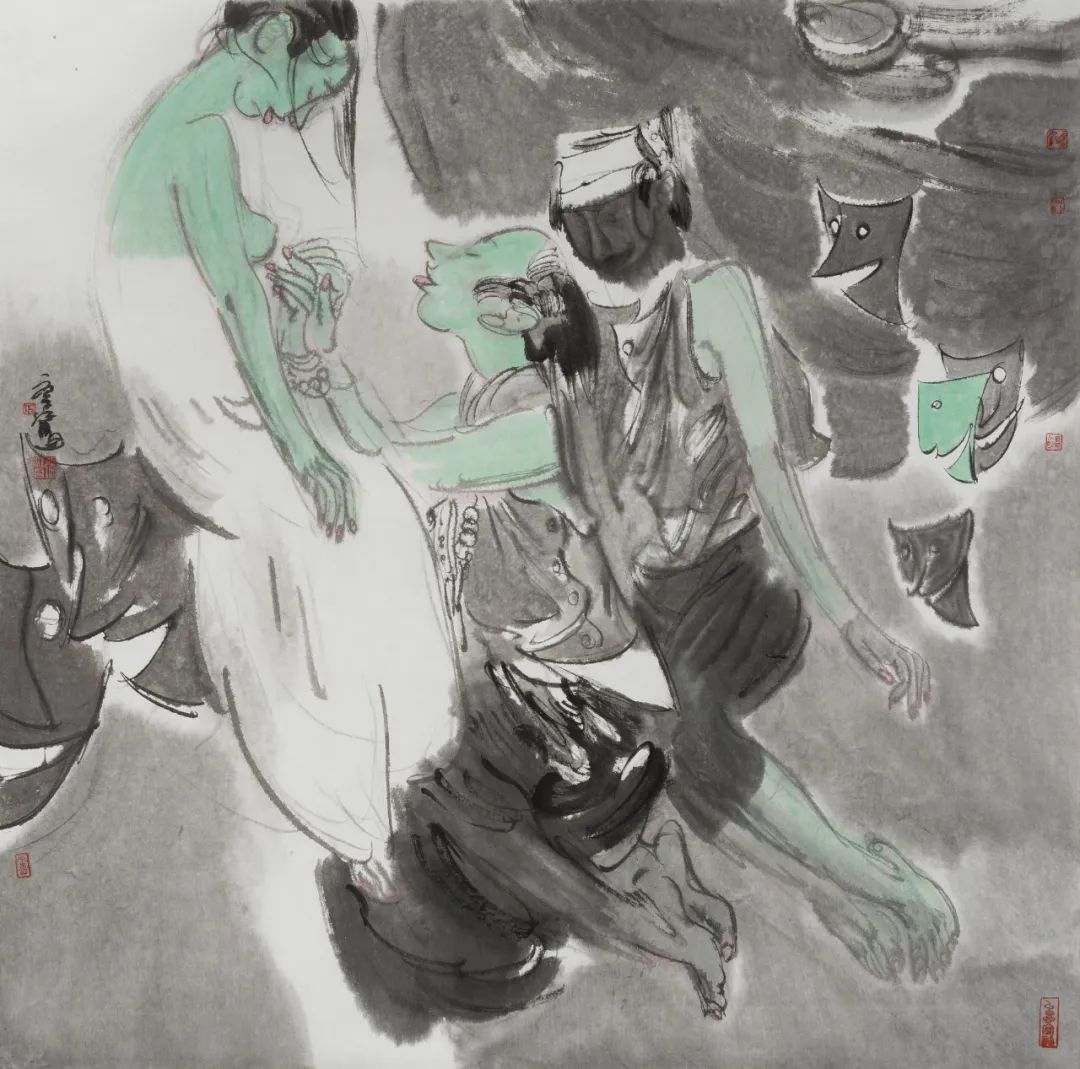
阙·辰|纸本水墨|130cm x 130cm 2020
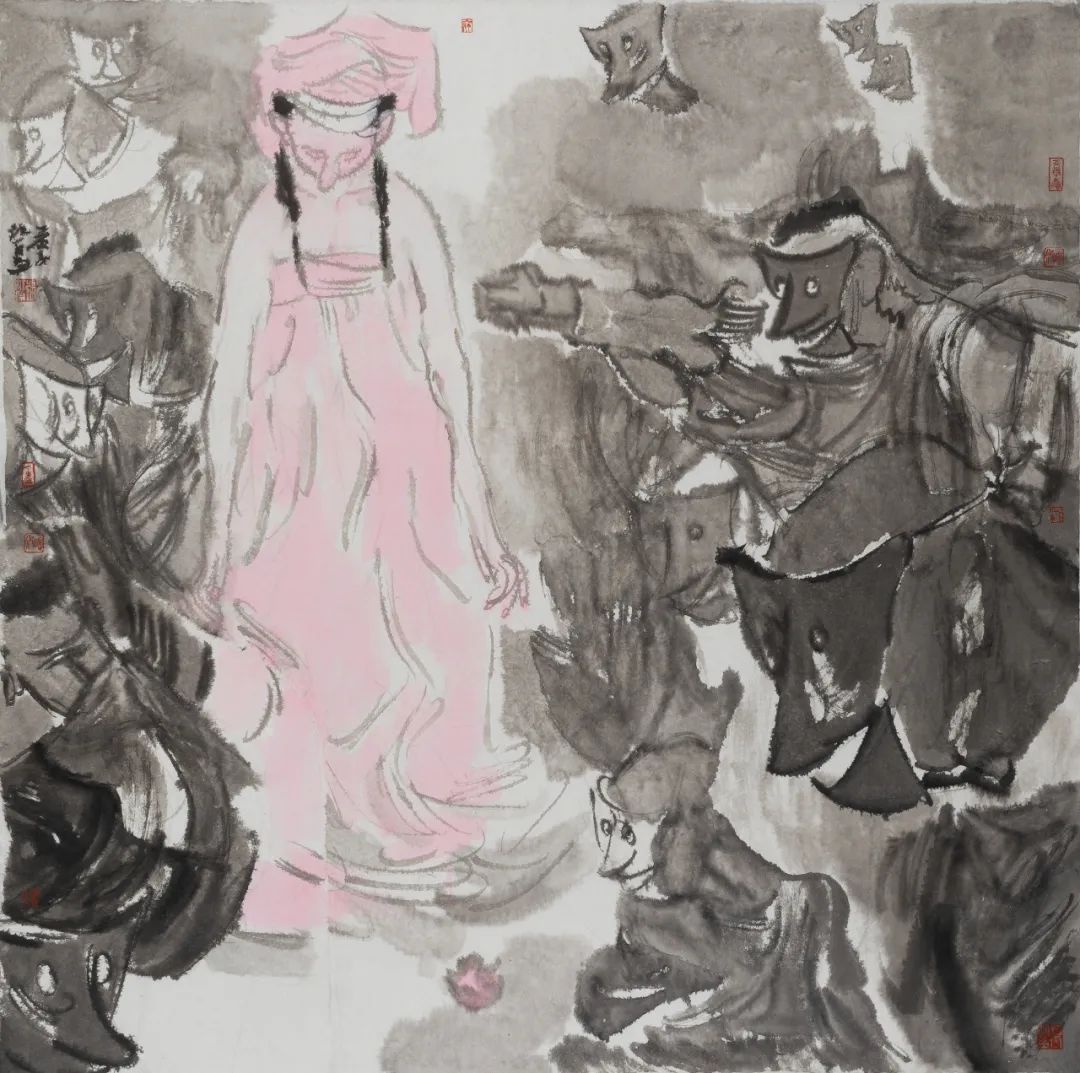
阙·巳|纸本水墨|130cm x 130cm 2020
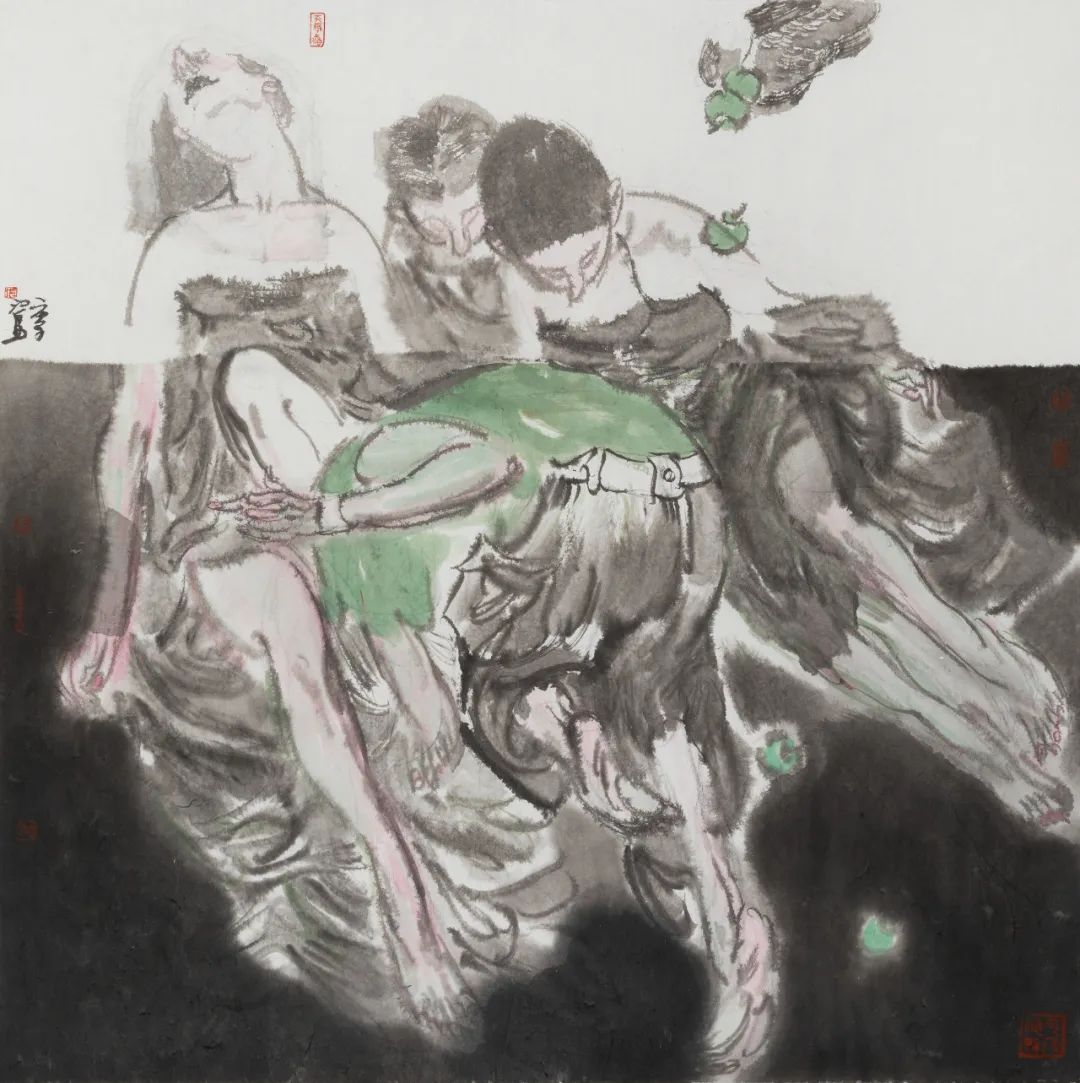
阙·午|纸本水墨|130cm x 130cm 2020
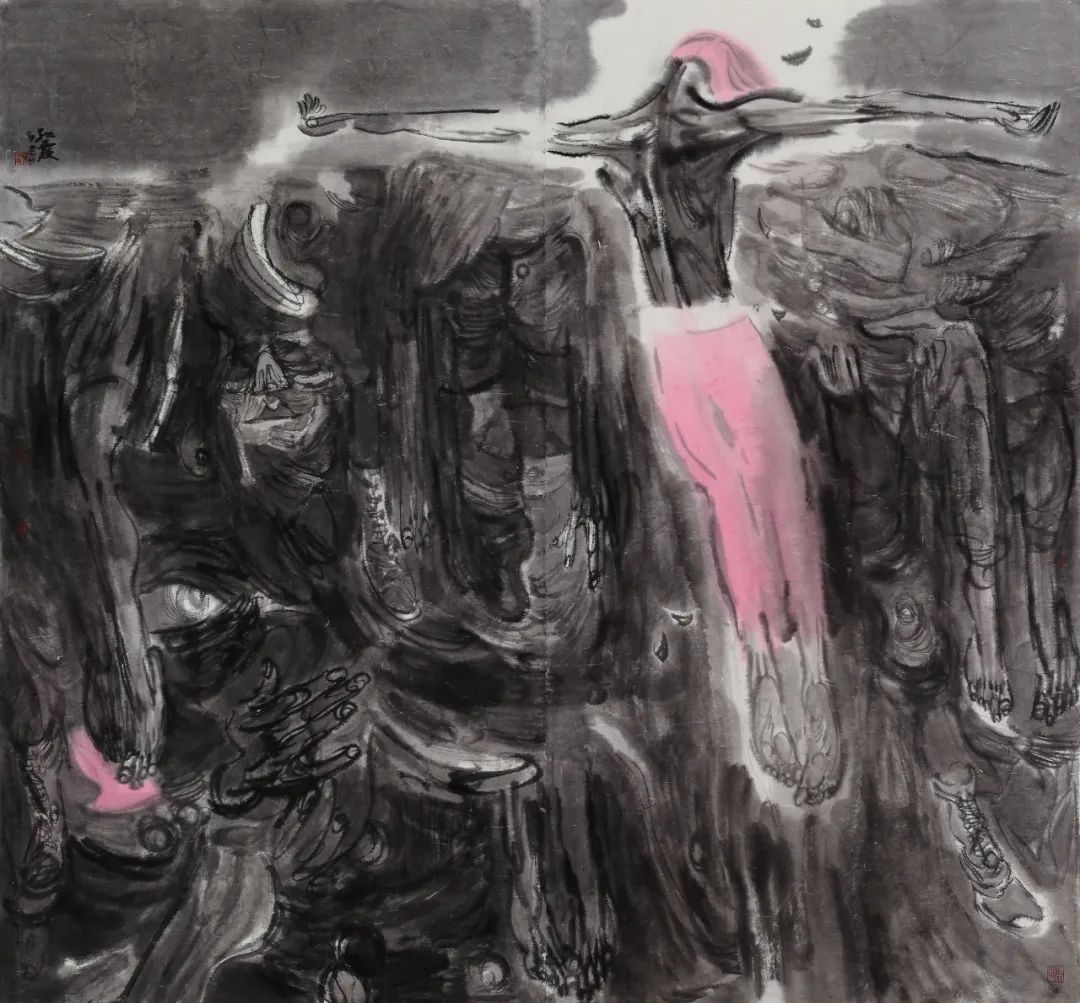
红霞|纸本水墨|200cm x 200cm 2021
在这些作品中,颜色的象征性使用——粉色和绿色的使用,也为水墨作品增添了亮度和清晰度,并将观众带入当代的语境。色彩在人群中捕捉情感,隐约可见一些真理:希望、力量、感情。这些旋转的,充满活力的作品大胆、忧郁,具有探索性。水墨的使用与笔触,晕染,线条动态结合,一切似乎都被拉向特定的方向,超出了被卷入这场风暴的人的控制。这种无助感似乎是他的创作中心主题,因为画面形象被呈现出紧贴、放手、觉醒、激动、生存、存在……这也符合了全球的生存形势。
在这些纸本水墨作品中,张江舟的情感倾泻而出,这是一种极具强迫性、紧迫感的创作输出,这也体现在作品中,体现在此时此刻的连贯性上。他的作品有些是三联画,以一种不连贯的画面方式紧密地叙述——它们作为一个叙述整体组合在一起,但它们也让人觉得故意地不连贯。人类的灾难被日常的平凡所抵消。关于存在的剧本以一种狄更斯式的相互竞争的故事情节展开,然而,它们是超现实的、身临其境的,淹没了我们的思想,抹杀了任何理性的理解方式。虽然他的作品中不乏厌世之情,但观者能从他饱含情感的作品中窥见他的人文主义情怀以及对万事万物寄予的深切同情,而这种悲天悯人的情愫则来自他恣意汪洋的艺术表达天赋。(文/何凯特,英国伦敦苏富比艺术学院现当代亚洲艺术项目主管、策展人)
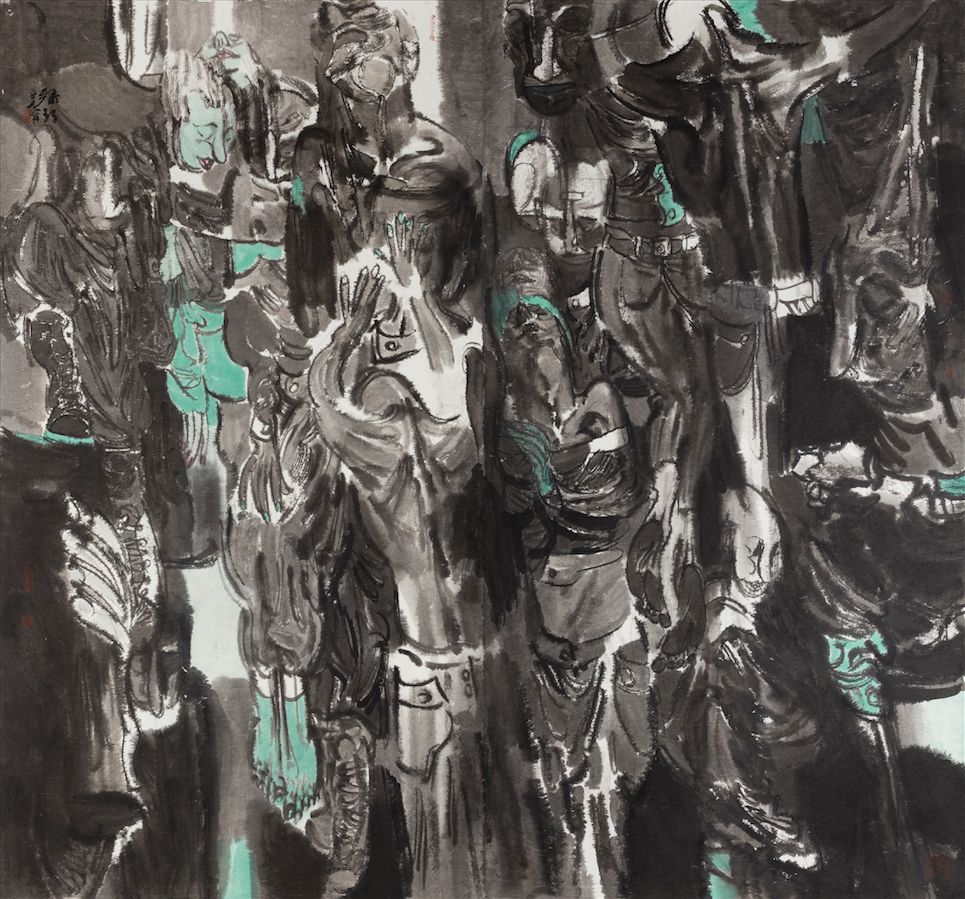
绿影|纸本水墨|200cm x 200cm 2021

Zhang Jiangzhou: ink and anxiety in the 21st century
The works of Zhang Jiangzhou recently shown in the exhibition Soul Whispers are intense and overpowering in their emotional impact. Employing ink to paint scenes weaving together line, wash and figuration, Zhang’s artistic language has evolved from elements drawn from Chinese and Western painterly lineages producing an overall humanistic theme of narrative and formalistic elements. Combining thick and wet brushstrokes with figurative line-drawing and form, a flattened perspective is used, crowded with elements featuring bodies, hands, eyes, people and animals all thrown together in a confusing array of imagery that is modernist and has elements of magical realism. The density is demanding and requires unpicking and reading, to see what is going on: who are we looking at? What is happening?
Incorporating figures with languid, expressionistic bodies and drawn-out hands evoking other modern and contemporary painters such as Kathe Kollwitz and Lucien Freud, densely woven compositions are alleviated only by the selective use of blank space prevalent in traditional Chinese painting. Glimpses of space are used within the pictorial plane to break up the density and sometimes to distance the picture’s narrative and allow a pause in the line of vision. Whilst the overall impression is a darkness and intensity showing saturated scenes of desperation, colour also lights up the images, highlighting single figures with touches of green and pink to enhance the sense of the individual within the mass. A small female figure, for example, is shown lifting up with pointed feet, elevating her in a moment of spiritual levity but she seems like a spirit, recalling Chagall’s fairy tale figures flying above the landscape.
The idea of the soul is strongly conveyed, as these seem to be pictures of existential angst, and images of human survival in an age of spiritual isolation. Zhang’s deep engagement with the psychological situation in the past two years of the pandemic, harnesses his previous experience with human distress and observations of society during tragic events such as the Sichuan earthquake. Tracing some of Zhang’s works over two to three years, there are both strong links and also departures in this series. The world changed from the end of 2019, and more than two years later, we are still reeling from this drastic global situation that has torn the world apart and led to mass isolation, fear and separation.

人类图像学研究-人格|纸本水墨|130cm x 130cm 2019
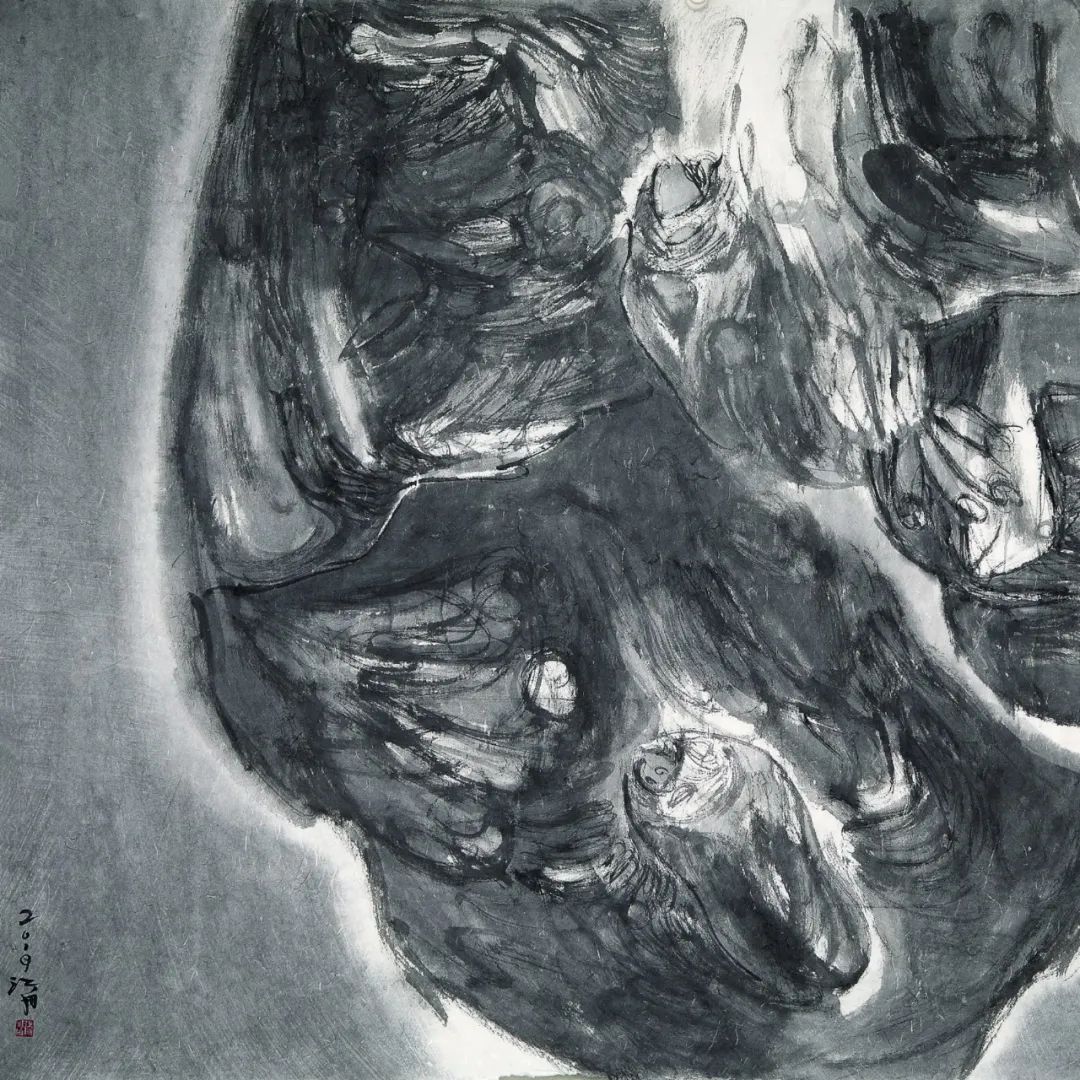
人类图像学研究-超象|纸本水墨|130cm x 130cm 2019
Two works deserve mention. Research on Human Imagery. Boundary 130 x 130 cm from 2019 seems to be an experimental work, but it is a disturbing image in black and white of a tightly clustered row of figures, heads all cast down with hands clasped around their heads, so that it is hard to know what is going on, but they appear to be subjugated. They appear isolated, but bound to each other, set against a blank space above and below, forming a line of human distress and suffering. Are they standing or sitting? They appear to be squatting or bent over. Large sets of fingers are drawn almost comically, somehow drawing out emotionality, as symbols of these figures’ humanity. It is almost abstract and conceptual but clearly figurative at the same time. This work feels universal as a picture of the human condition, portrayed as timeless and transcendent.
A second work, produced in 2021, is the large-scale Haze in Spring, 200 cm x 400 cm, that exemplifies this 2021 series. In a chaotic figurative narrative, the sections have clearly depicted figures, young female figures standing out in the dark, difficult environment. A young girl wearing a mask appearing to clutch a teddy bear, walking towards the viewer, a woman to the left, with bare arms and midriff, looking down on a blurred mass, perhaps a family member succumbing to the virus. A heavily clothed but barefoot woman wearing a hat, pushing a supermarket trolley glancing towards us, with a large trainer poised bizarrely in front, blocking our line of vision. Shots of green pick out details such as a woman’s top, the girl’s hair and boots, and what appears to be a cat, so that the domestic becomes visible in a sea of uncertainty, whereby everyday life has to continue, regardless. This work is interesting in its depiction of life, perhaps extracted from scenes Zhang has observed, taken and reinterpreted into a storyline, that is fragmented but compelling.
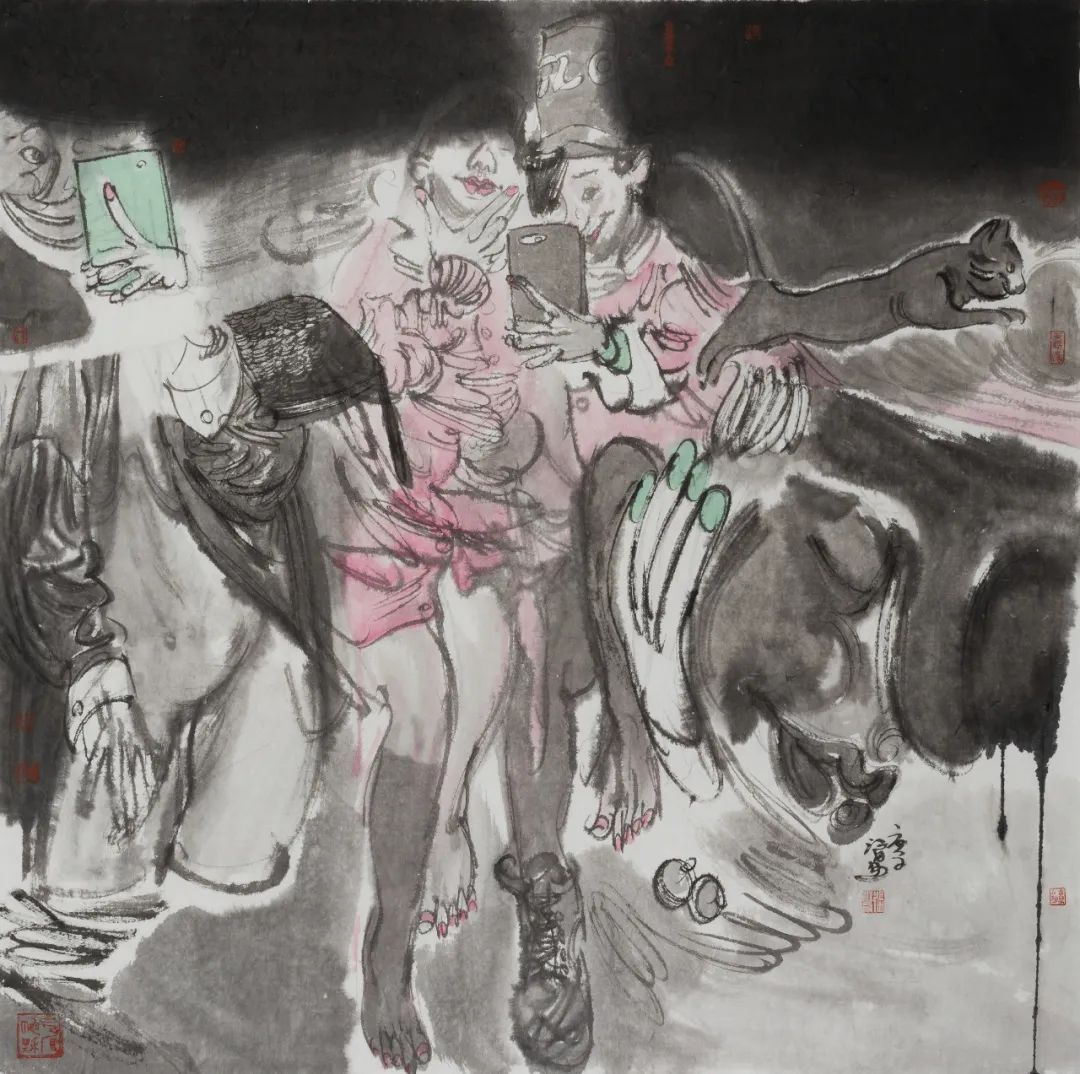
阙·申|纸本水墨|130cm x 130cm 2020
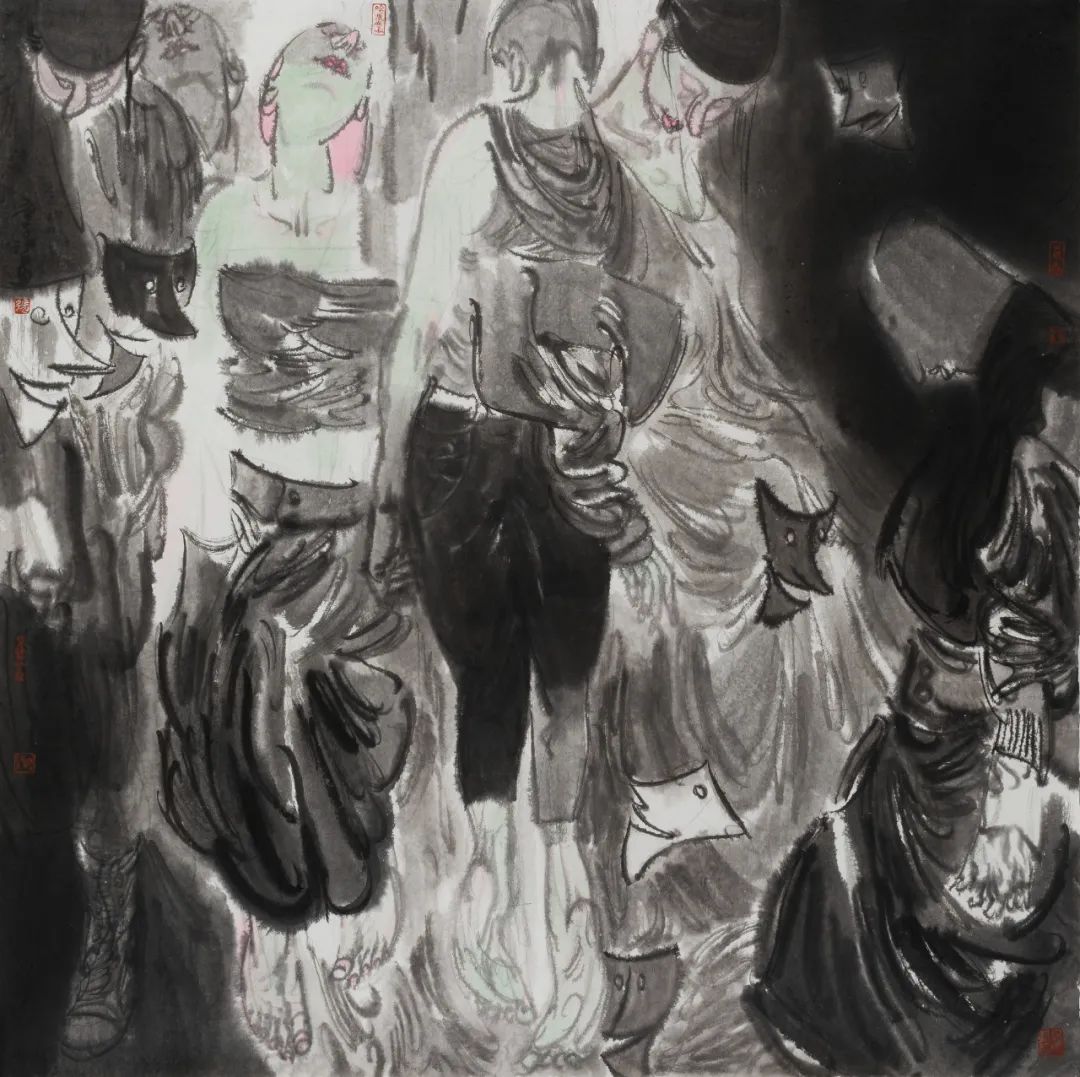
阙·酉|纸本水墨|130cm x 130cm 2020
The Q works, framed by the twelve Earthly branches of the ancient system of time, are more of a chaotic narrative, not easily made out. Blurred images have to be scrutinised and searched until we start seeing something. A figure, some legs, pointing feet with clear, delicate toes; a face, a woman in contemporary clothes. Anxious faces, sprawled bodies, scenes of seeming mayhem, scenes that make no real sense.Can we really 'read' these paintings? A sensation of unease, blurriness, disjointed lives, snippets of existence make us, the viewer feel giddy, unhinged, confused. These works come from a period much longer than two years...perhaps several decades, perhaps several hundred years or more - thousands! Ink in China has a long and continual history from such early masters as Gu Kaizhi onwards and the continuous accumulation of visual language draws on this history, bringing it into the present, pushing conventions of ink into a pictorial language that is humanist, reaching a potency in its full and moody descriptive power. Wash is used extensively and the tonal description of ink shows its full range from a pitch black to the palest grey, offset by the greens and pinks used for aesthetic and symbolic effect, breaking into a contemporary language that emphasizes the surreal and uncanny and enhances the dream-state of the imagery.
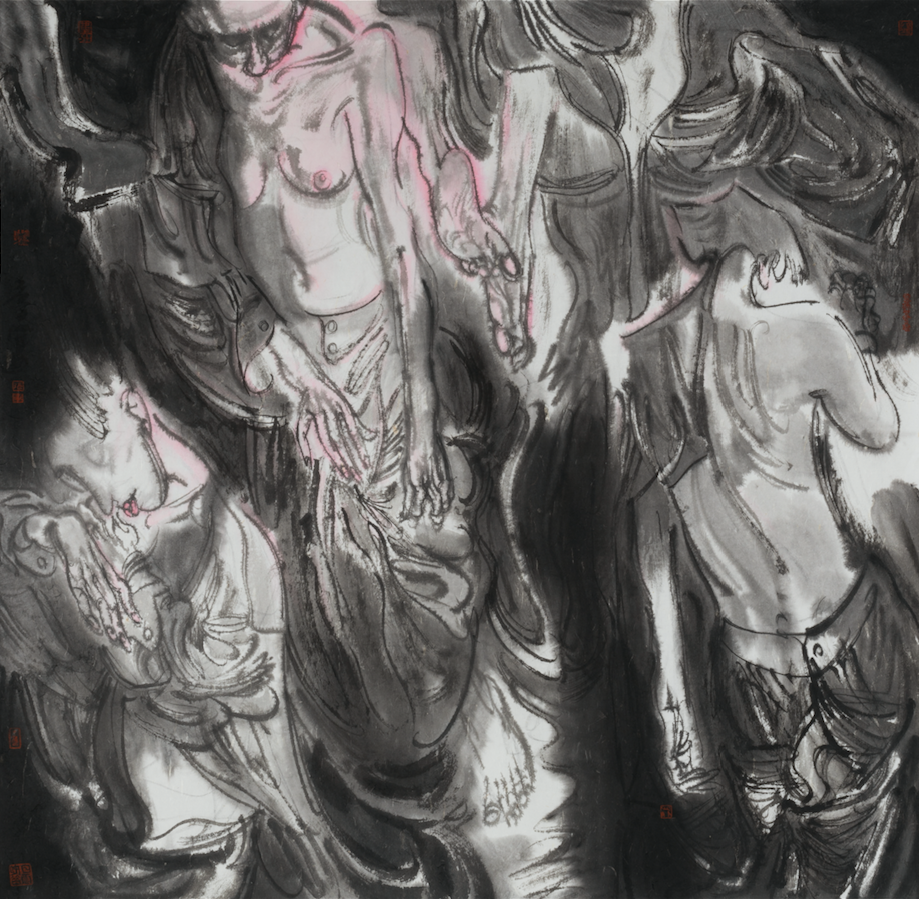
阙·戌|纸本水墨|130cm x 130cm 2020
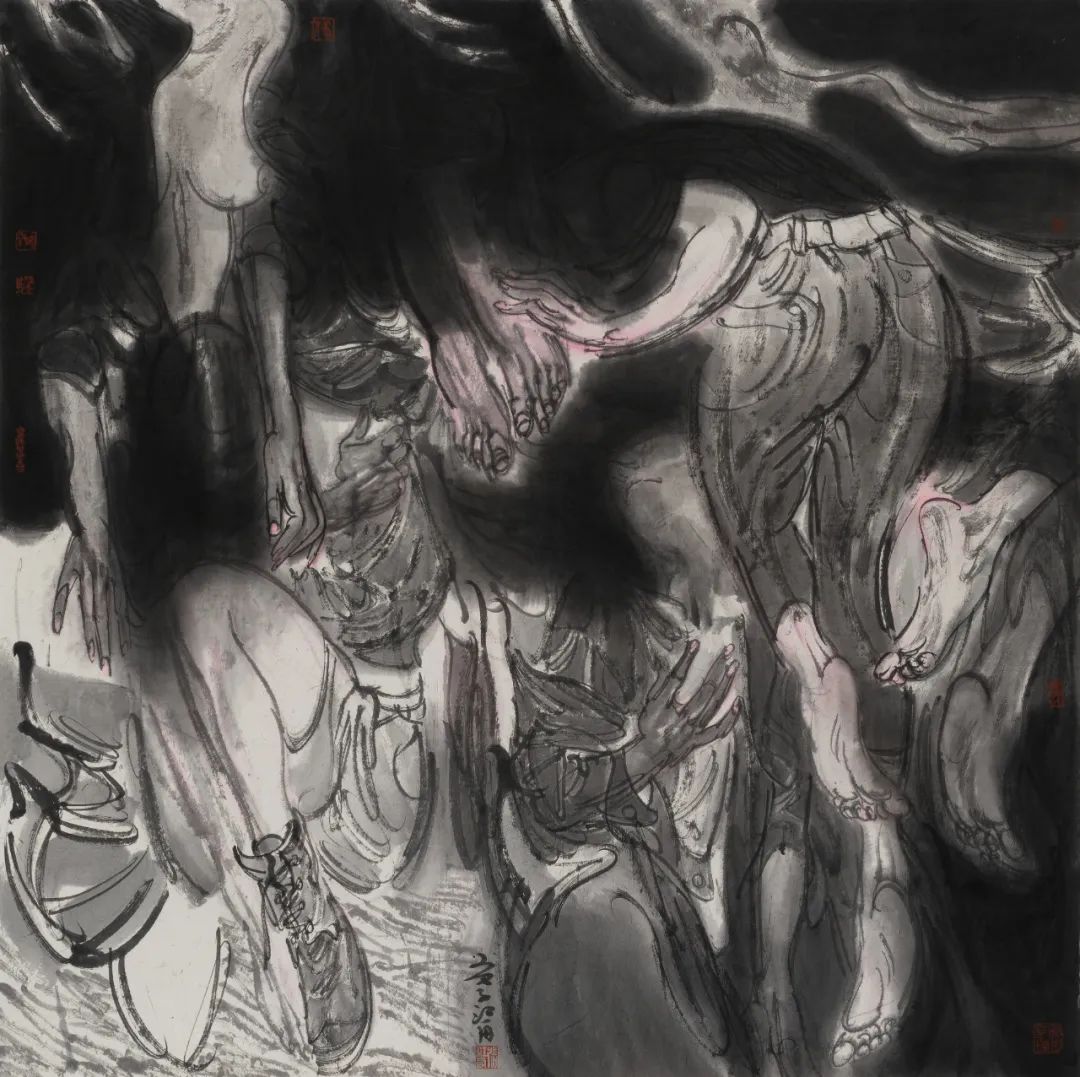
阙·亥|纸本水墨|130cm x 130cm 2020
What was already there in essence can be seen in some of the 2019 works: a condensed, parted down cluster of totemic parts, the totem pulling elements that appear consistently: large, heavy hands, hands that are ancient, holding on, clutching, symbols of common humanity that date back to prehistoric times. These works are tightly conceived, forceful, enduring, produced using a direct form of expression that is loaded with emotional import. Amorphous forms are compact and sculptural, entailing a kind of binding together, some of the imagery recalling neo-modernist works from the post-war German artist, Baselitz and other forms of art from the early twentieth century in response to disaster and war. What we see is a paradox of the fragmented elements drawn together; sometimes, this clustered amorphous form, recognisable as traces of the human, is isolated at the centre of a void, a vast expanse within which it is centred, alone but intact, as though the very spirit has survived even when all else collapses around it.
There is a progression in scale in Zhang’s works in the recent period. The 2021paintings are huge, made up of sections, expanding the terrain of human drama across themes of love, loss, solace and abandonment. The effect is to amplify the humanity, rendering it more epic and urgent.
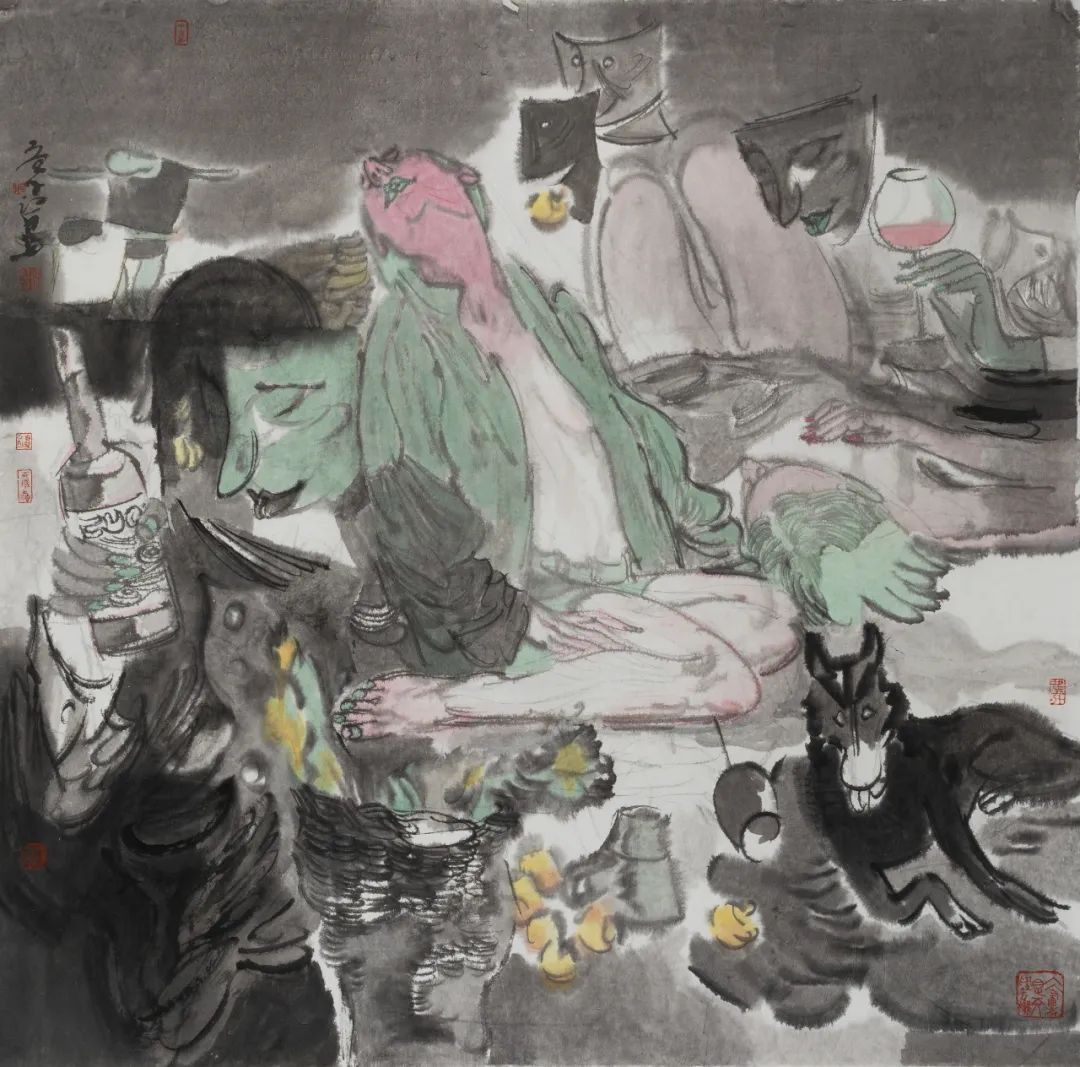
阙·未|纸本水墨|130cm x 130cm 2020
The backdrop of humanist cultural expression in Chinese art can be relevant to understanding these contemporary works. After the first burst of humanism appeared in paintings in the late1970s, the decade of reform in the 1980s allowed such expression to expand and diversify, alongside literary, photographic and cinematic trends. In ink, the most enduring of artistic forms since at least the Song dynasty, there has been a real renaissance of the medium in China during the past three decades. Echoes of modern ink works seem to sit alongside other traditions of modern art, with elements of German expressionism, and pish masters such as Goya, perhaps Velazquez even coming to mind. The fusion of expressionism and abstraction hovers here between a surreal disturbing and dreamlike vision, and a kind of mundane, lived reality of everyday life. Floating, suspended figures recall (to my eyes) Chagall, and other earlier Christian paintings in the Western canon, all there in ghostly form, barely discernible but echoed in some way. Nature, spirituality and human suffering are visible in an anguished swirl of survival, compassion, swimming in and out of focus, watery, fluid and uncertain. Zhang’s own painterly voice is complex, layered and borne of decades of a sustained artistic practice, exploring the medium and honing his subject matter to a level of fluency and immediacy that provides a direct and powerful visual communication.
What is compelling about these works is their refusal to be clearly read, clearly understood, leaving space for confusion and questioning, as reflected in their visual style content abs also in their titles. As a series, they are carefully framed within sets of ideas, lending rigour to their creation as a quest, a kind of exploration of a state of being that is characterised by overwhelm, anxiety and the urgent need to survive.
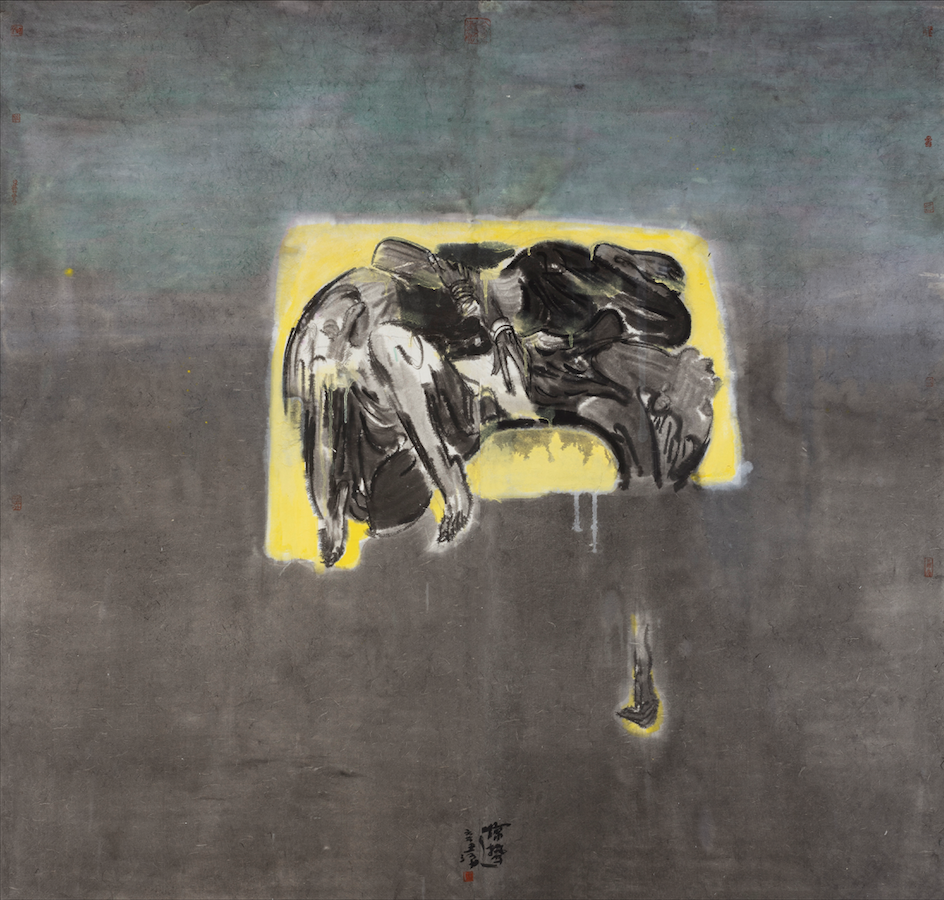
惊蛰|纸本水墨|200cm x 200cm 2021
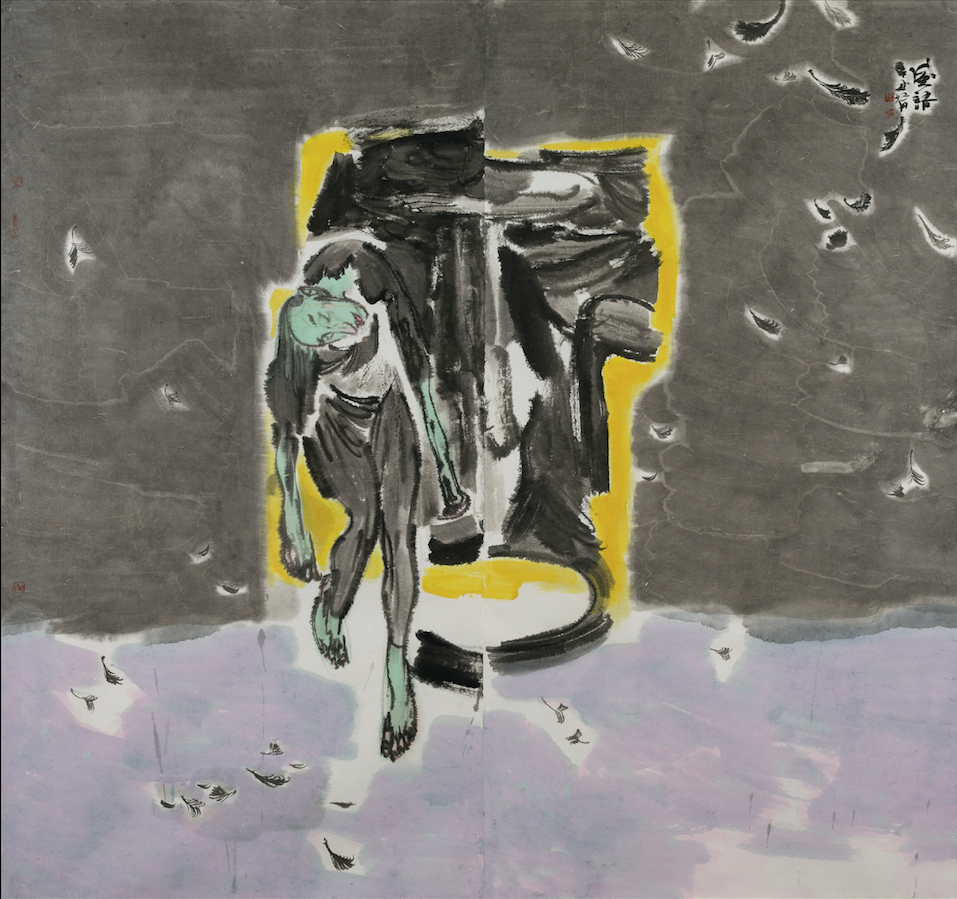
风语|纸本水墨|200cm x 200cm 2021
The symbolic use of colour in these works, - the use of pinks and greens, also add a lightness and clarity to the ink palette, jolting the viewer into the contemporary moment. Glimmers of some truth held up in the capturing of emotion amongst the throng: hope, strength, heart. These swirling, energetic works are bold, moody, searching. Ink is used with sweeping strokes, wash, lines, building dynamic compositions that are moving as everything seems to be drawn into certain directions, beyond the control of those caught up in this storm.Ideas about helplessness seem to be central themes, as people are presented clinging on, letting go, waking up, stirring, living, existing...a survival that tallies with the local and global situation.
Zhang has poured out these scenes in these works of ink on paper in a compulsive flow of creative output, that has a sense of urgency, reflected in the works and their coherence at this moment in time. Some are triptychs, held in a close-knit narrative of pictorial disjuncture - they fit together as a narrative whole, but they also feel deliberately disjointed and awkward. Human catastrophe are offset by everyday mundanity. The dramas of existence are laid out in a kind of Dickensian fray of competing storylines; yet they are surreal and immersive, swamping our thoughts to blot out of any rational means of understanding. With Zhang’s humanism and depth of empathy, despite the despair, we feel some warmth and glimpses of redemption in these strong emotive works. His generosity lies in the gift of this painterly outpouring.(Katie Hill, Programme Director of MA Modern and Contemporary Asian Art, Curator)
画家简介
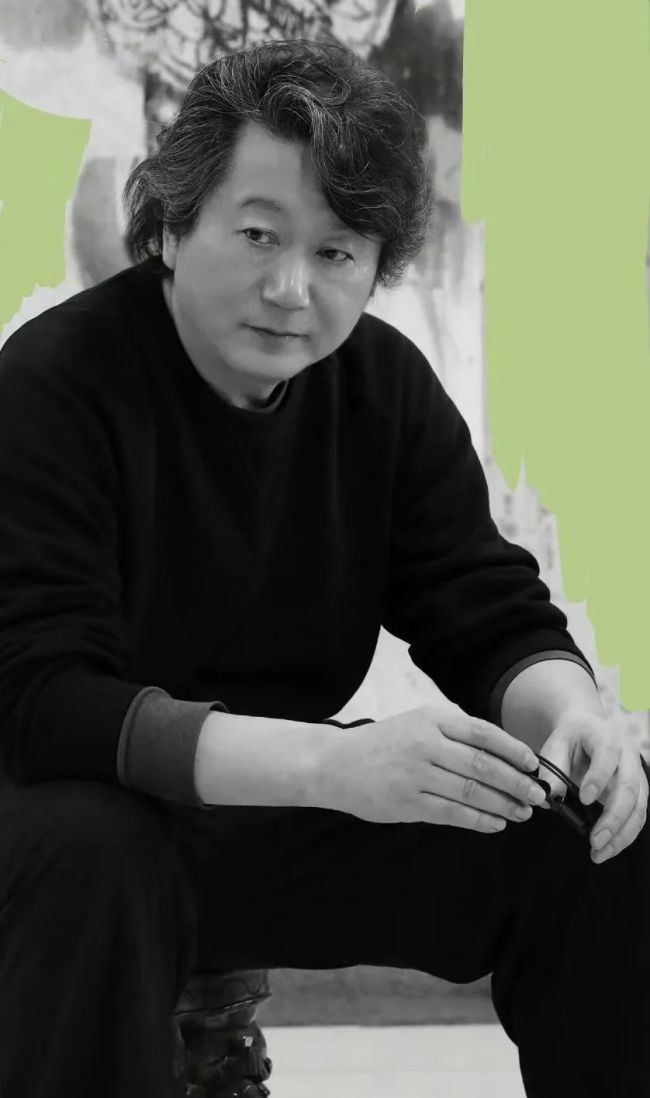
张江舟,当代水墨艺术家,中国水墨人物画领军者之一。中国国家画院院委、研究员、博士生导师。俄罗斯国家艺术科学院荣誉院士、中国美术家协会理事、中宣部文化名家暨“四个一批”人才、文化部优秀专家,享受国务院特殊津贴专家。曾任中国国家画院副院长、《水墨研究》执行主编。
